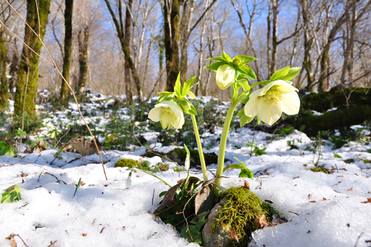
There are many Christmas carols and songs that include the image of the Christ child as a rose. “Lo, How a Rose E’re Blooming” is a famous one, made even more so from the modern pairing of that 17th century hymn with the contemporary pop song “The Rose” by Amanda McBroom. “When Blossoms Flowered ‘Mid the Snows,” is another one such with its lines:
When blossoms flowered ‘mid the snows
Upon a winter night,
Was born the Child, the Christmas Rose,
The King of Love and Light.
(This song was originally titled “Gesu Bambino,” written by—you guessed it—an Italian.)
So I had always vaguely thought of the image of a rose, possibly a red one for contrast, blooming against the white snow, a miraculous event like the story of Christmas itself. And that would indeed be a beautiful image, except for one problem:
The reference is not to a rose. It’s to a completely different plant. And I knew that perfectly well because I have grown a variety of that plant in my yard. Just shows how dense I can be.
The plant in question is called a “hellebore.” Doesn’t sound too attractive, does it? Its name refers not to the nether regions but to poison. (Great improvement, right?) The Greek words that are used mean “harmful” and “food.” Parts of the hellebore are poisonous, so they’re a good choice if you have problems with deer and rabbits eating your plants. There are several varieties, including one called the “stinking hellebore.” It’s actually a very attractive plant with pale green flowers, and it’s only the crushed leaves that smell bad. (Who figures this stuff out?)
But there are two main types, the black hellebore and the Oriental hellebore, or, for our purposes, the Christmas rose and the Lenten rose, so named because of when they bloom. (The word “black” refers to the color of the roots.) Hellebores are fantastically hardy, with leathery leaves that stay pretty much evergreen throughout the winter. And, as shown in the picture above, they can actually bloom while there’s still snow on the ground. The ones I grew were the later-blooming Lenten roses, which have a range of beautiful colors; Christmas roses typically come only in white with a pink tinge .
So on to how the connection to Christmas was made. Flower legends are pretty common: someone thinks, “Hmmm. Where did that plant come from?” The black hellebore with its beautiful winter blooms would obviously attract attention. How was it possible that there could be such a thing? And so a story grew up. Here it is:
The Legend of the Christmas Rose is a charming tale of a little shepherd girl named Madelon.
As Madelon tended to her sheep one cold and wintry night, Wise Men and shepherds passed by Madelon’s snow-covered field bearing gifts for the Christ Child. Following, Madelon saw the Magi present gold, myrrh and frankincense to the baby…even the humble shepherds had brought fruits, honey and doves to give to the babe…but Madelon had nothing, not even a simple flower for the Newborn King. Standing outside the stable where Jesus had been born, poor Madelon wept, wishing that she had a gift she could carry to the infant. A watching Angel, taking pity on Madelon, caused the snow at the feet of the small girl feet to vanish, thus revealing a most beautiful white flower whose petals were tipped with pink, formed by the Angel from the tears which had fallen from the eyes of the little shepherdess. Overjoyed, Madelon presented her gift at the manger of the baby Jesus…her gift of the Christmas Rose. (“The Christmas Rose”)
This tale was never meant to be any kind of historical incident, of course, so it would be kind of mean-spirited of me to point out the numerous problems with it. I will just mention, once again, that according to the actual Christmas story in the Christian New Testament the Wise Men did not come to the stable. (See my post “Who Were the Magi?”)
At some point the Christ Child acquired the title of “Christmas rose.” While Jesus is never called a rose in Scripture, there is a reference to the coming Messiah being a “branch” in Isaiah 11:1: “And there shall come forth a rod out of the stem of Jesse, and a Branch shall grow out of his roots.” The Song of Solomon says, “I am the rose of Sharon, the lily of the valley.” (both references from the KJV), and this poetic statement has in some circles been made to refer to Christ; I’ve sang the old Gospel song “I Have Found a Friend in Jesus” in church many times, and it has the line:
He’s the Lily of the Valley, the Bright and Morning Star,
He’s the fairest of ten thousand to my soul.
So I’ve now replaced that mythical red rose in the snow with a real flower in the snow. And I’ll never look at hellebores in quite the same way now that I know their symbolism.
Here’s a gorgeous, gorgeous performance of “Lo” by a men’s choir:
Here’s the famous pairing in a choral arrangement:
And here’s “Gesu Bambino”–
And, just for fun, the old Gospel song I mentioned, sung by one guy on all four parts. I have no idea who he is, but boy, is he great!
© Debi Simons

